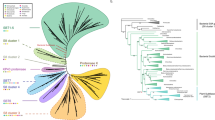Abstract.
Many genes for calmodulin-like domain protein kinases (CDPKs) have been identified in plants and Alveolate protists. To study the molecular evolution of the CDPK gene family, we performed a phylogenetic analysis of CDPK genomic sequences. Analysis of introns supports the phylogenetic analysis; CDPK genes with similar intron/exon structure are grouped together on the phylogenetic tree. Conserved introns support a monophyletic origin for plant CDPKs, CDPK-related kinases, and phosphoenolpyruvate carboxylase kinases. Plant CDPKs divide into two major branches. Plant CDPK genes on one branch share common intron positions with protist CDPK genes. The introns shared between protist and plant CDPKs presumably originated before the divergence of plants from Alveolates. Additionally, the calmodulin-like domains of protist CDPKs have intron positions in common with animal and fungal calmodulin genes. These results, together with the presence of a highly conserved phase zero intron located precisely at the beginning of the calmodulin-like domain, suggest that the ancestral CDPK gene could have originated from the fusion of protein kinase and calmodulin genes facilitated by recombination of ancient introns.
Similar content being viewed by others
Author information
Authors and Affiliations
Additional information
Received: 11 July 2000 / Accepted: 18 April 2001
Rights and permissions
About this article
Cite this article
Zhang, X., Choi, J. Molecular Evolution of Calmodulin-Like Domain Protein Kinases (CDPKs) in Plants and Protists. J Mol Evol 53, 214–224 (2001). https://doi.org/10.1007/s002390010211
Issue Date:
DOI: https://doi.org/10.1007/s002390010211




